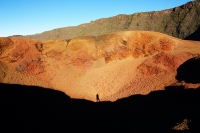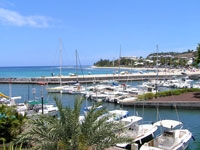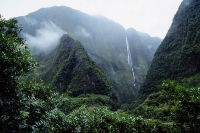Reunion is a fascinating geological destination, with its rugged valleys and volcanic landscapes softened by lush forest. The Plaine des Sables is a stark ash and lava rock plain at the foot of Reunion's volcano, which feels like a moon landscape. The Piton de la Fournaise Volcano, the only active volcano on the island, and indeed one of the most active in the world, is thrillingly accessible to the adventurous. The Riviere des Remparts Canyon is a steep and beautiful river valley, and the three cirques, deep circular canyons, lure visitors with scenic overlooks and exciting hiking trails.Of course, Reunion is also a celebrated beach getaway, with its tropical climate and lovely coastline. Visitors should note that the beaches on the western coast of the island, between St Gilles-les-Bains and Hermitage-les-Bains (where many hotels can be found) are sandy and comparatively safe, making this the best stretch of coastline for families and those seeking calmer waters. Much of Reunion's coast, though beautiful, is rocky, with rough surf. Those snorkelling and swimming should also bear in mind that shark attacks do occasionally occur off the coast of the island; it is worth researching where the attacks most commonly take place and consulting locals and the coast guards when in doubt. Those fond of marine life should visit the Kelonia Marine Turtle Observatory, dedicated to the study and conservation of Reunion's resident turtles.

Reunion's volcano last erupted in 2016 and is currently one of the world's most active, along with Kilauea in Hawaii. The volcano is spectacular and is one of the island's principal attractions, rising 8,565 feet (2,611m) above sea level. High cliffs, deep craters, legrandbrûlé(the burnt slopes) and lava streams create a stunning scene. In the past, lava streams have flown into the sea, destroying the main highway along the way. Eruptions usually occur within the caldera and therefore pose little threat to people.The walk to the summit takes roughly five hours and it is well worth finding out in advance about weather forecasts as cloud cover can roll in quickly, preventing hikers from being able to make the climb. An alternative way to explore the area is by helicopter, although this is naturally a more expensive option.Saint Paul, former capital of the island, is the closest town to the volcano and has a lovely street market (on Friday afternoons and Saturday mornings), two miles (3km) of black-sand beaches, fine examples of traditional Creole houses, a seaside cemetery and other historic sites.

Close to Saint-Paul, on the northwestern side of the island, Saint-Gilles-les-Bains is a highly popular weekend destination, offering a beautiful 12-mile (20km) lagoon and gorgeous white-sand beaches. Saint-Gilles was once a sleepy fishing village, but now it is Reunion's most popular resort, attracting crowds of visitors intent on enjoying the leisure activities, watersports and lovely beaches. Snorkelling, scuba diving and swimming are a must, but those tired of the beach can head to the Garden of Eden, a lovely botanical garden with roughly 700 species of tropical plants. Saint-Gilles has plenty of hotels and restaurants, though these tend to get very crowded at peak holiday periods and weekends.

Reunion is blessed with spectacular natural beauty and one of the island's most remarkable features are the three main cirques, Cilaos, Mafate and Salazie. A cirque (or caldera) is a natural amphitheatre, created by the movement of ancient glaciers or, as is the case for Reunion, volcanoes collapsing in on themselves.Salazie is perhaps the most striking, home to roughly 100 waterfalls, most notably The Bride's Veil ( Le Voile de la Mariée) near Hell-Bourg, as well as lush vegetation. Cilaos has long been the site of a spa resort, providing thermal baths for the wealthy inhabitants of the area since the 1800s. It was also once a refuge for runaway slaves. Today it is still known for the Irene Accot Thermal Centre; a must for weary hikers. Mafate is the most remote of the cirques and its name is derived from the Malagasy for 'lethal,' illustrating the difficulty of accessing the area. Mafate is dotted with tiny hamlets (the largest is La Nouvelle) and there are no proper roads, so the only access is on foot. The cirques provide unparalleled hiking opportunities and unspoilt wilderness, and are within a few hours of Saint-Denis.

Travel Guide powered by Word Travels, copyright © 2023 Globe Media Ltd. By its very nature information in this travel guide is subject to change at short notice and travellers are urged to verify information on which they're relying with the relevant authorities. Neither Globe Media Ltd nor Travel Vogue can accept any responsibility for any loss or inconvenience to any person as a result of information contained above.